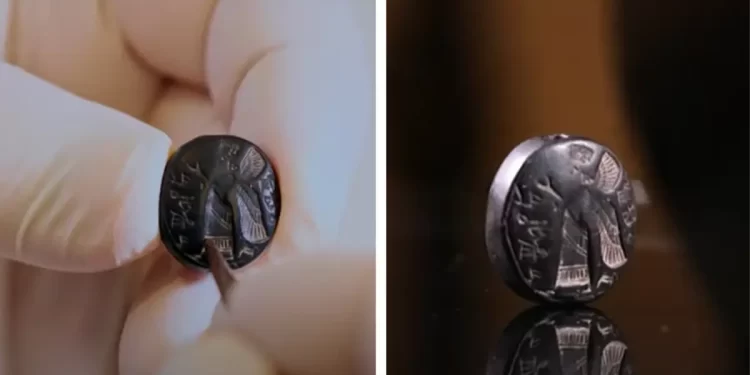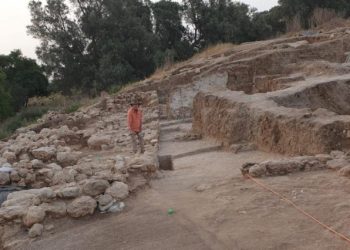A remarkable archaeological discovery dating back 2,700 years has surfaced in Jerusalem, shedding light on the cultural influences in the Kingdom of Judah. The Israel Antiquities Authority (IAA) announced the unearthing of a rare stone seal from the First Temple period, featuring an intricate depiction of a winged figure, believed to be a protective “genie” or demon, along with an inscription in paleo-Hebrew script. The artifact was discovered in the Davidson Archaeological Garden, located to the south of the Temple Mount in Jerusalem’s Old City. This find was part of ongoing excavations led by the Israel Antiquities Authority in collaboration with the City of David Foundation. The seal, which can be worn as a pendant thanks to a hole running through it, showcases a winged figure that bears a striking resemblance to Assyrian depictions of genies or protective demons. This connection underscores the Assyrian cultural influence that permeated ancient Jerusalem, particularly during the First Temple period.
Experts have highlighted the exceptional rarity of this discovery, marking the first instance where a winged genie has been identified in the archaeology of Israel and the surrounding region. The seal encapsulates elements of both Judaic and Assyrian traditions, providing insight into the cultural intersections present in Jerusalem at that time. The artifact, estimated to be approximately 2,700 years old, bears the inscription “LeYehoʼezer ben Hoshʼayahu” — translated as “For Yeho’ezer son of Hosh’ayahu” — in paleo-Hebrew script. According to the IAA, the seal likely belonged to a high-ranking official in the Kingdom of Judah, possibly used to authenticate documents or other official materials. Describing the imagery, the IAA detailed that the figure is shown in profile, with wings, dressed in a long, striped garment, and moving to the right. The figure is adorned with long, curled hair falling over the nape of the neck and wears a headpiece resembling a hat or crown. One arm is extended forward with an open palm, possibly holding or indicating an object.
Dr. Filip Vukosavović, an expert in Assyriology and an archaeologist with the IAA, emphasized the uniqueness of this discovery, noting that it is the first of its kind in both Israeli and regional archaeology. Winged figures like this were common in Neo-Assyrian art from the 9th to 7th centuries BCE and were considered protective entities. Interestingly, experts suggest that the seal initially featured only the winged figure, with the text being added at a later stage. It is believed that the item originally served as an amulet, likely worn by Hoshʼayahu, a prominent figure in the administration of the Kingdom of Judah. Professor Ronny Reich of the University of Haifa observed that while the engraving of the winged figure was done with precision, the paleo-Hebrew inscription appears to have been added with less care. This combination of Assyrian iconography with a Hebrew name reflects the broader cultural context of the time, where local identity coexisted with the influences of dominant neighboring cultures. This seal not only exemplifies the cultural syncretism of the period but also offers a tangible connection to the complex identity of ancient Jerusalem’s inhabitants, who balanced local traditions with broader, foreign influences, much like many people in Israel today identify with both local and Western cultures.











